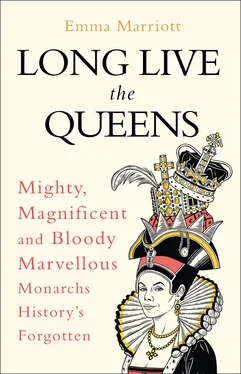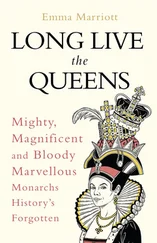Some female rulers, deemed ‘rebels’ in this book, fought against mighty and rapacious empires, controlling husbands or the restrictions placed on them as queens. Other rulers did well to survive, as being a queen is not necessarily an easy ride. Girls from noble families, bred to be dynastic pawns, were sent off to strange lands at ridiculously young ages, often to marry much older men before suffering pregnancy after pregnancy, the death of infants, perilous court factions, and a less-than-welcoming attitude by many men to women having so much as an ounce of power. To survive all of that and then actually achieve something – well, that definitely is worth remembering. A sixth sense seems almost to have told some queens that they needed to make their mark, stamping their authority as image-makers on coins, on statues and in monumental structures that some male successors even attempted to pass off as their own. The guiding lights of this world are queens who provided wise counsel to their husbands or subjects, or who defined the role of queenship for others to follow in their stead.
They’re all here – fearsome elephant-riding warrior queens, ruthless trailblazers, cross-dressing rebels, lusty free-thinkers, tough-as-boots survivors and enlightened guiding lights. It’s time to find out just how mighty, magnificent and bloody marvellous these forgotten queens really were.



Born: circa 1031
Died: 1083
William the Conqueror, who in 1066 defeated King Harold at the Battle of Hastings during the Norman Conquest of England, remains a legendary figure. But what of his queen? Who is aware of the considerable role she played in supporting and facilitating the invasion, or that she was the first Queen of England to be crowned separately in Westminster Abbey? How many could even recall her name?
William’s queen was, unsurprisingly, better known in France, in particular the region of Normandy, where she and William ruled as Duke and Duchess. Raised in the powerful medieval principality of Flanders, Matilda was of noble birth, grand-daughter of a king of France (King Robert II, who died in 1031) and descendant of the Frankish emperor, Charlemagne, and the Saxon king, Alfred the Great. William had impressive lineage through his father, Robert I, Duke of Normandy, but his mother was the unmarried Herleva of Falaise, a lowly tanner’s daughter. Although William would later defiantly sign his name ‘William Bastard’, he could never quite shake off the taint of bastardy and would react violently if taunted.
Legends tell of Matilda first refusing William’s offer of marriage on account of his illegitimacy, publicly declaring to the Duke’s envoys and her father Count Baldwin that ‘she would not have a bastard for a husband’. Her father had hoped for a closer alliance with the ruler of Normandy, but he was forced to turn William down (a rare occurrence when high-born women were generally forced into arranged marriages). Tales then tell of a furious William riding to Bruges, dragging Matilda off her horse by her long braids and throwing her into the mud. Count Baldwin was rightly outraged, although Matilda is said to have enjoyed this display of raw machismo, deciding then that William was the man for her. The story smacks of male fantasy and indeed formed part of a scurrilous volume full of anti-Norman sentiment penned by monks two centuries after the event – hardly a reliable source on which to draw an accurate picture of a Norman ruler, never mind a female one. It is just as likely that her change of heart was brought about by having been turned down herself by a former suitor, the Saxon leader Brictric, for reasons unknown.
Whatever the cause, the marriage went ahead in 1050, in defiance of Pope Leo IX, who initially forbade the match partly on the grounds that the couple were distantly related. Matilda was at most nineteen and William twenty-three. By all accounts the marriage was harmonious from the outset, with a papal dispensation later awarded by Pope Nicholas II. It was said that Matilda ‘united beauty and gentle breeding with all the graces of Christian holiness’ – attributes typically expected of noble women of the period.
As wife to William, Matilda fulfilled her principle duty of procreation, bearing ten children who survived into adulthood, including the two future English kings, William II and Henry I. Although their marriage was a strategic alliance, it seems to have been one of genuine love and trust and, unusually for a medieval ruler, William was not known to have had any mistresses or to have fathered any illegitimate children. It also proved to be an effective ruling partnership: Matilda witnessed countless charters and presided with William in court when he heard lawsuits, and they both founded and sponsored churches and religious institutions across the duchy.
With such a capable ally at his side, William was able to turn his attention to further horizons, namely that of the Crown of England which, he maintained, Edward the Confessor had promised him. As he built his immense fleet in preparation for invasion, Matilda secretly outfitted a ship, the Mora , and stood at its prow as it sailed into harbour. So astonished and thrilled was William that he used it as his flagship (as shown in the Bayeux Tapestry – an embroidered cloth depicting events leading up to the Norman Conquest of England). Before leaving for England, William solemnly invested Matilda with the regency of Normandy, safeguarding to her the protection of the duchy in the name of their fifteen-year-old eldest son, Robert.
These were turbulent times in Normandy and William’s absence could well have prompted others to try to seize control of the French duchy. Despite this, there were no major uprisings or rebellions during William’s leave and it was said that Matilda presided over the court and government with great prudence and skill, William of Poitiers conceding the ‘government was carried on smoothly’ by a woman of ‘masculine wisdom’ (‘feminine wisdom’ being deemed pretty much non-existent back then).
Across the Channel, William had by Christmas Day 1066 secured the crown of England, although it was over a year before Matilda would visit his new realm. At around Easter of 1068, she landed at Dover, where she was met by her king and a company of nobles. They escorted her to the palace of Westminster and on 11 May she was anointed with holy oil and adorned with a crown, ring and sceptre at an elaborate ceremony at Westminster Abbey. In England, queen consorts had been crowned with their kings since 973, but Matilda was the first to have a separate coronation, in a revised service which proclaimed that she shared royal power with the King, almost as if she were a queen regnant. It was a coronation that, unlike any service before, boosted her power and prestige as queen and secured that of her successors.
With such holy honours bestowed on Matilda, she would have been aware of her weighty responsibilities as Queen. As wife to the King, she was expected to support and love her husband, produce healthy heirs, and embody the virtues of piety and virtue by patronising religious institutions and giving to charity. As England’s queen, her gifts to religious houses are well documented – ‘while the victorious arms of her illustrious spouse subdued all things before him, she was indefatigable at alleviating distress in every shape, and redoubled her alms’. Matilda was also a great patron of painters, architects and poets in England, bringing Flemish artisans to the country and employing English seamstresses who were famed for their skills. (It was once wrongly thought she commissioned the Bayeux Tapestry, on which she makes no appearance.)
Читать дальше









![Джеффри Арчер - The Short, the Long and the Tall [С иллюстрациями]](/books/388600/dzheffri-archer-the-short-the-long-and-the-tall-s-thumb.webp)





